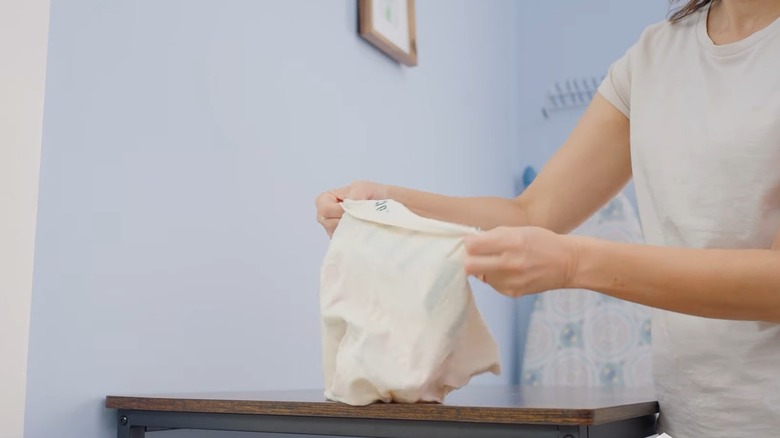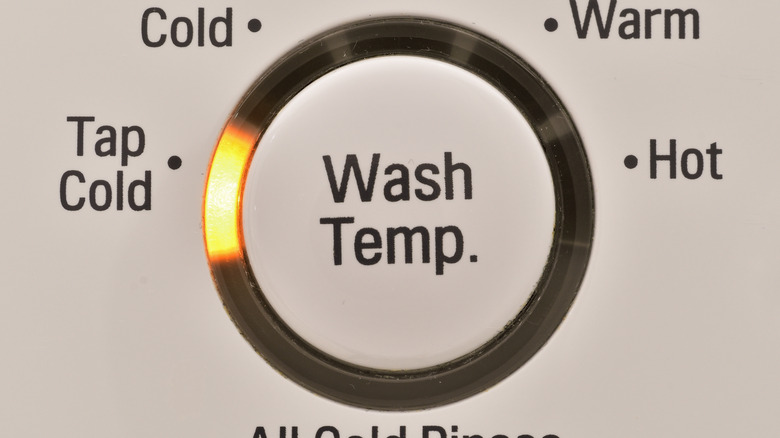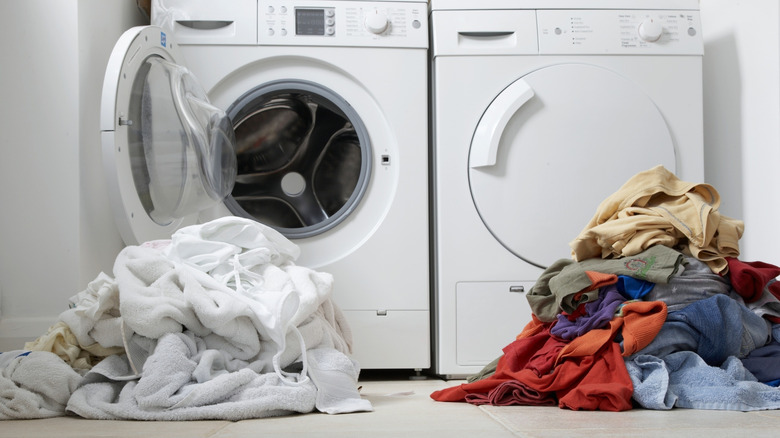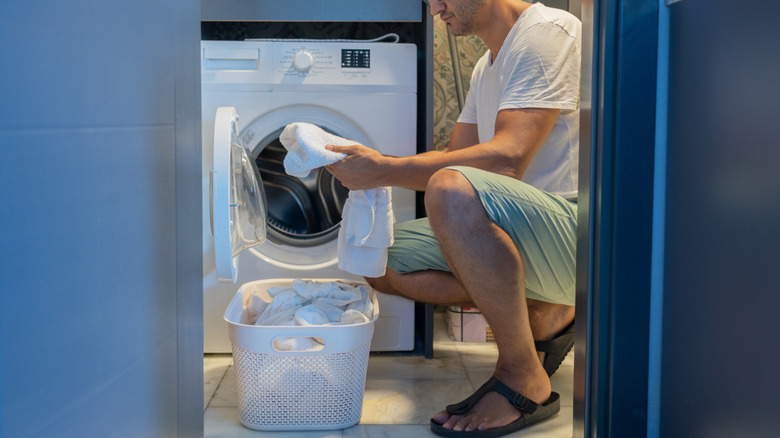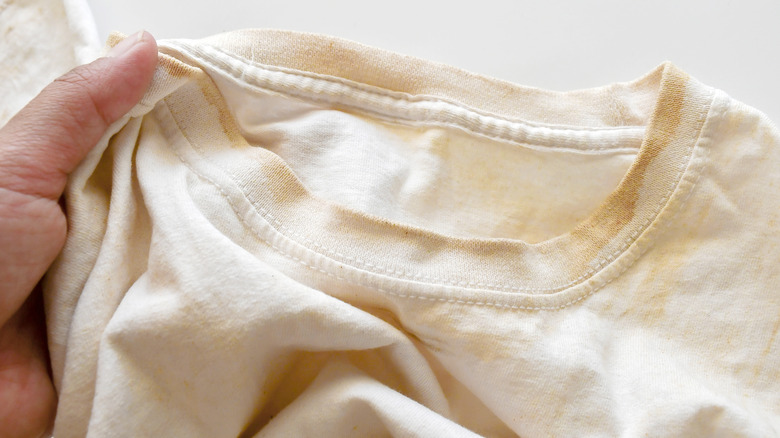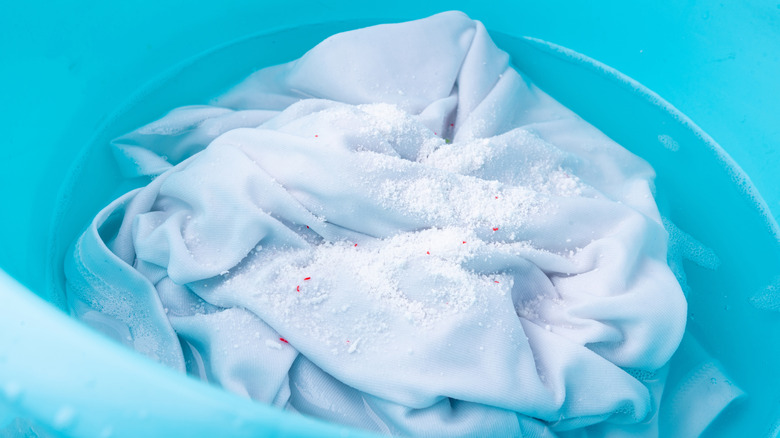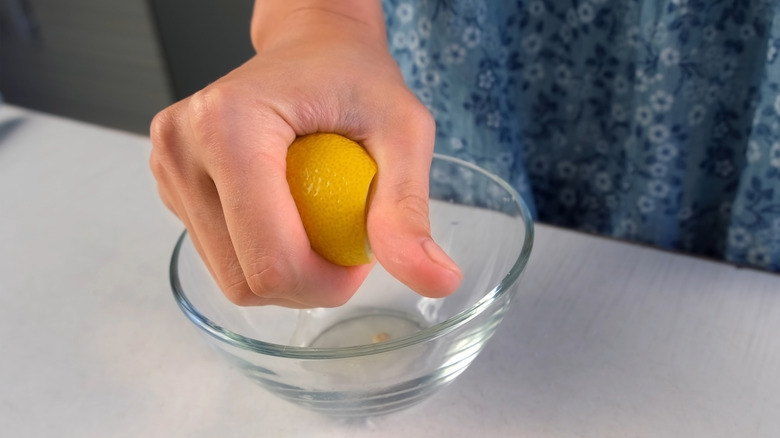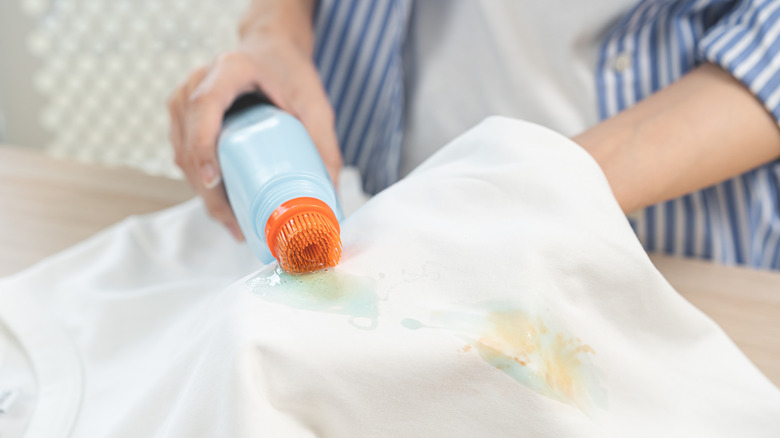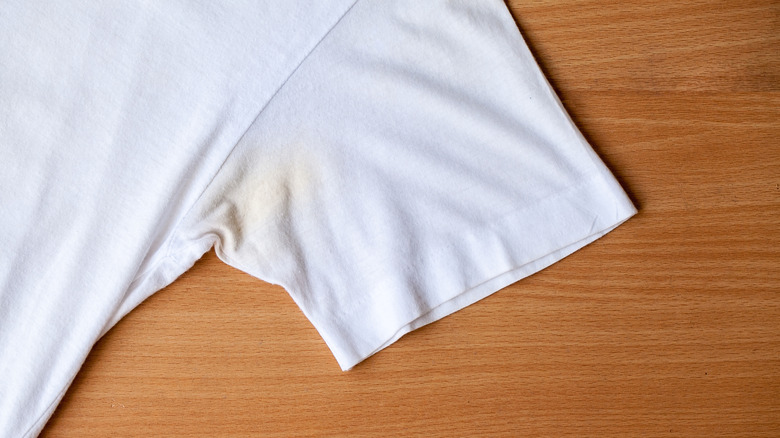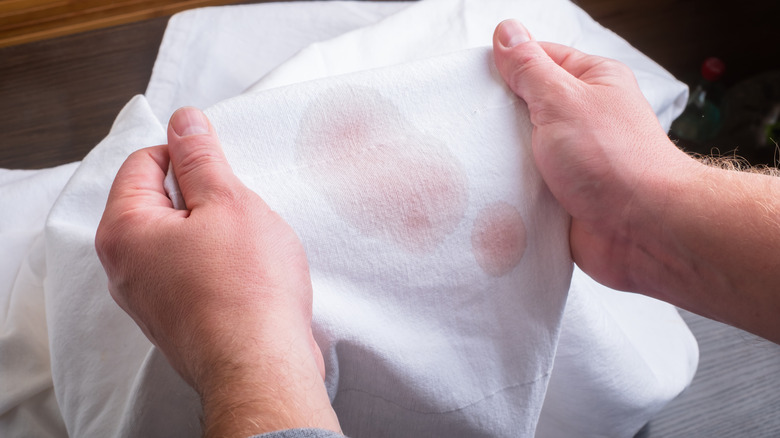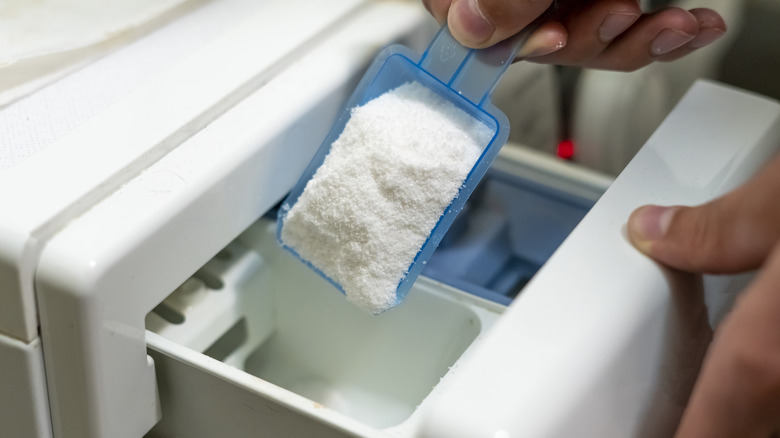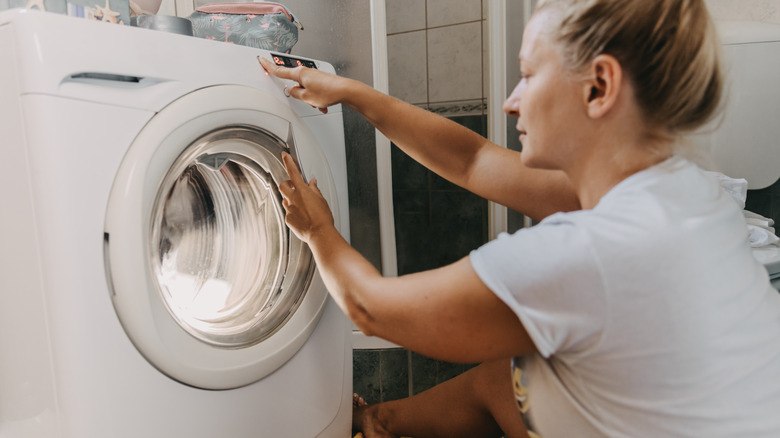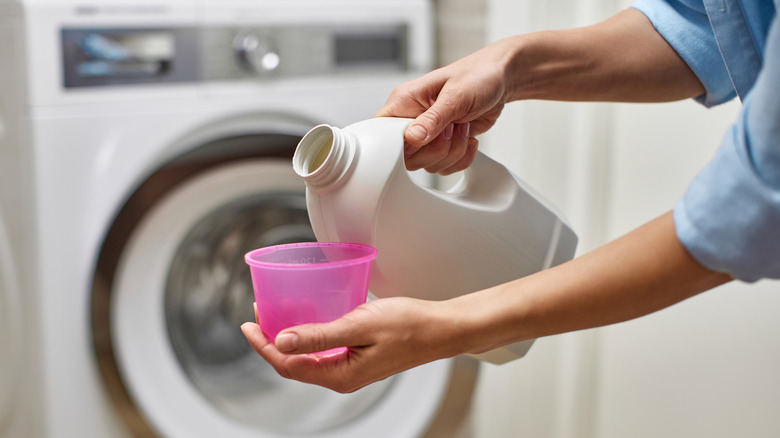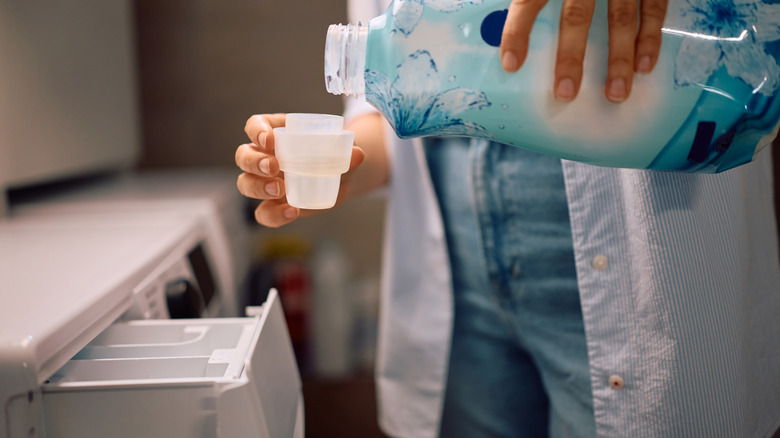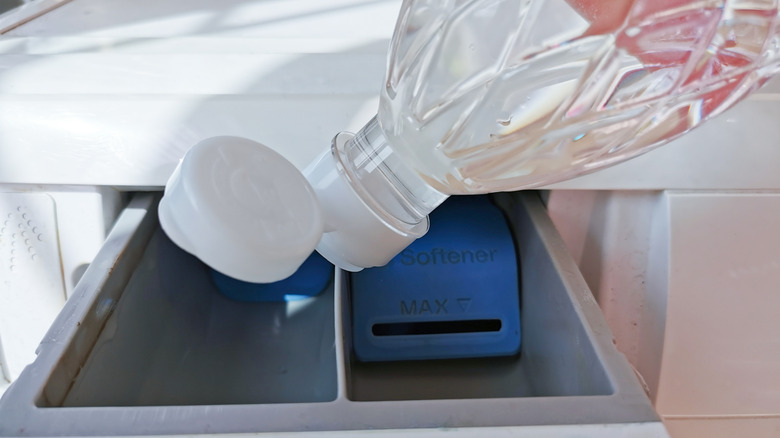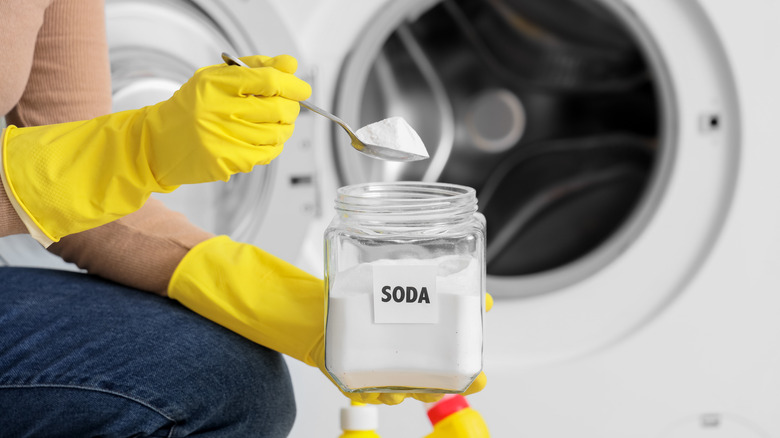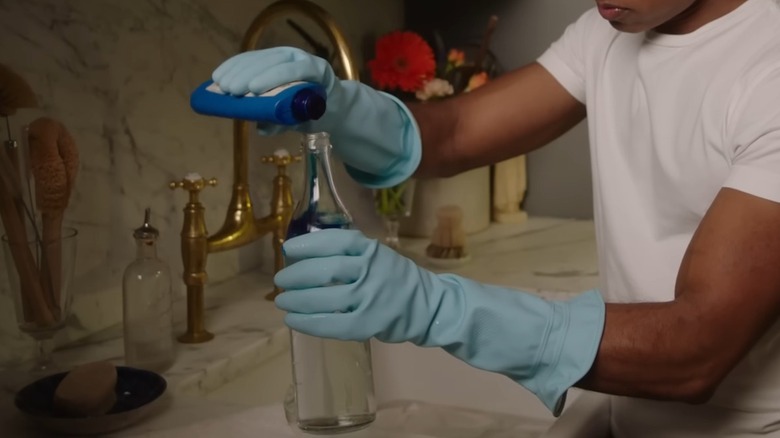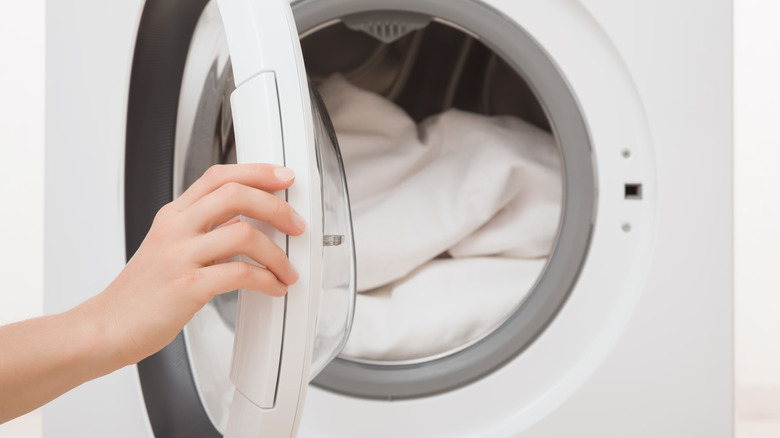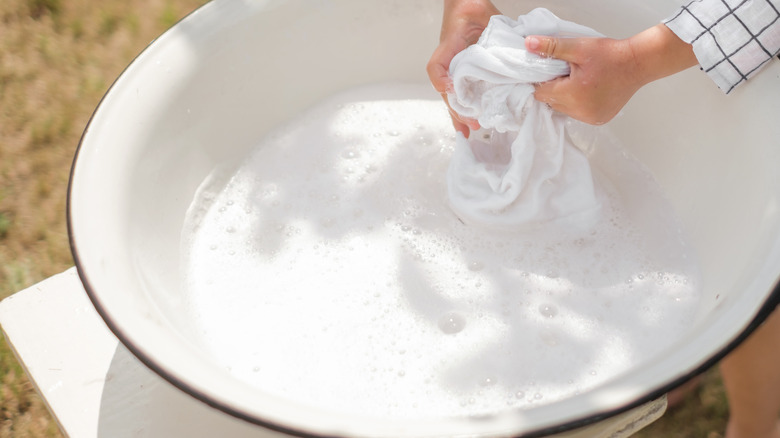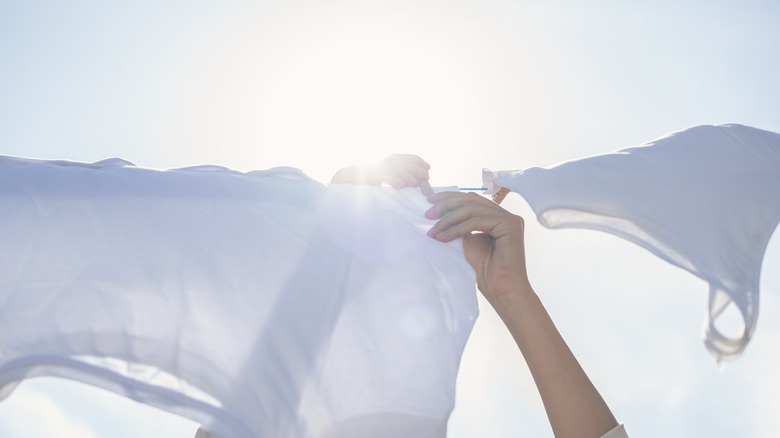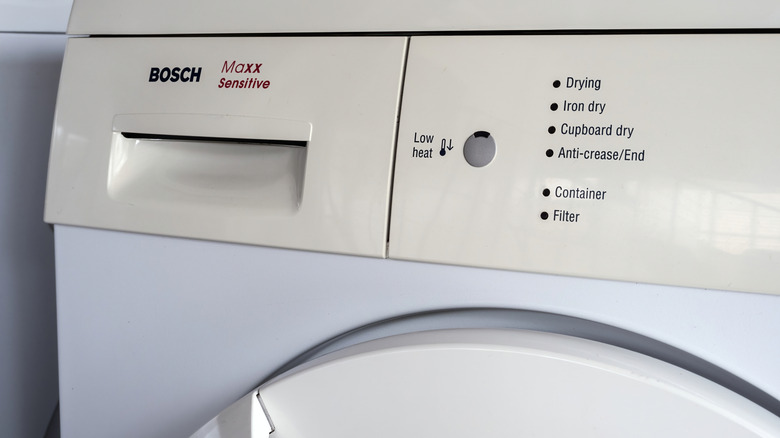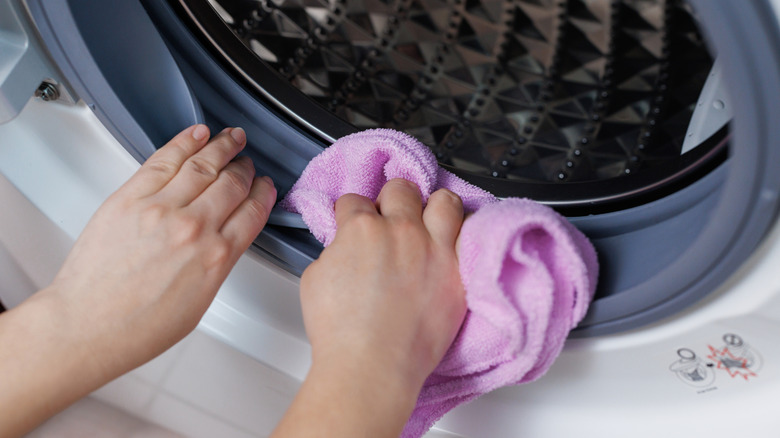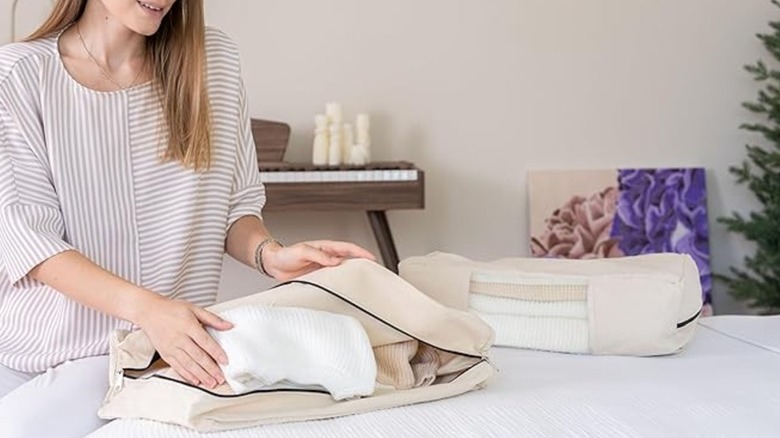All The Laundry Hacks You Need To Know To Prevent Your Whites From Fading
We may receive a commission on purchases made from links.
Your white shirt might be your pride and joy, but the latter won't last long if the garment loses its sheen or turns yellow too soon. The same goes for your expensive white silk dress and the trousers you convinced yourself were well worth the price tag. So, try preserving the original brightness of your milky whites as long as possible. A good starting point is to always follow the manufacturer's instructions and launder your clothes as well as linens accordingly.
Another laundry tip is to avoid using too much detergent since it can leave residue behind and make your articles seem dingy. You also want to avoid staining them. If that's not possible, prevent stains from setting in. And never rub them in since it'll help them penetrate the fibers better. Worse, it'll agitate the fibers unnecessarily and give your pieces a faded look. Washing them in cold water, not overloading the washer, using distilled white vinegar or baking soda, and air drying them are a few other laundry hacks that will keep your clothes in tip-top shape. Want to know more about ways you can prevent your whites from fading? Here are 24 hacks to assist you in your seemingly impossible quest.
Always wash them inside-out
An easy laundry hack to prevent your whites from fading is to turn them inside-out before putting them in the washer. This will reduce the wear and tear the fabric will be subjected to, so it'll remain looking new for longer. Bonus advantage: It'll be easier for your washer to target the side your skin comes into contact with, helping it remove body oils and sweat. If this seems like too much work, ask each family member to flip their white clothes inside-out before tossing them in the laundry hamper.
Wash them in cold water
You might think that your whites will get cleaner if you choose the hot water setting, but it won't do you any favors. It's because hot water will agitate the fabric more and make it seem worn after just a few washes. Plus, the color might fade sooner. To ensure your whites last longer, always select a cold water cycle. That being said, you can use warm water to tackle stubborn stains. However, don't forget to check your garment's care label to ascertain if it can handle such temperatures or whether it would shrink.
Don't wash your whites and colored garments together
An important step you shouldn't skip when starting a load of laundry is to sort your garments based on their color. Separating your white pieces from the colored ones will prevent the former's discoloration and keep them looking bright. While at it, put your white sequined or beaded pieces aside, too, and hand wash them. In case you don't have the time or inclination to sort your clothes, use Shout's Color Catcher Dye-Trapping Sheets to ensure your white clothes come out of the washer looking white.
Re-wash victims of color bleeding
In case you forget to sort your whites from their colorful cousins and don't use color catcher sheets, try re-washing the white garments that sport signs of color bleeding. Since the colors haven't had time to set in yet, they'll be easier to get rid of. Simply toss out the dark and bright garments prior to putting back the rest and running a regular wash cycle. Remember, this practice only works if you re-wash your spotted whites immediately; it wouldn't give you satisfactory results if the dye has had time to set in.
Avoid overstuffing your washer
After pulling your whites from your colors, it can be tempting to wash it all in one-go. Alas, this can be a bad move, especially if you have a lot of white-colored garments. Overstuffing your washer will not only make it more challenging for the appliance to distribute water and detergent to your clothes, but it'll also force it to work harder and create more friction between your loaded items. To prevent overloading your washer, always fill your machine's drum ¾ of the way. In other words, leave about 6 inches of gap between your whites and the top of your washer.
Never mix extremely dirty clothes with mildly soiled ones
If you want your white shirts to look pristine after a wash, avoid mixing them in with your muddy white pants. It's because the latter will turn your otherwise clean shirts dirty, too, and affect their brightness. In case this continues for a while, your milky garments will lose their sheen over time and start looking faded. This is why you should pre-soak all your extremely dusty and muddy garments for some time prior to chucking them in the washer along with your mildly dirty white articles.
Yellowed and muddy whites will benefit from a detergent soak
Want to ensure your mud-soaked white trousers don't corrupt your milky dress in the washing machine? Or, maybe you want to try and save your slightly yellowed garments? Soak them in a detergent and water solution for about half an hour prior to washing them. Simply add ¼ cup of powder clothes detergent in 1 gallon of heated water and give the mixture a good stir. It works because a majority of powdered detergents use sodium hypochlorite, a.k.a. chlorine bleach, which helps whiten garments made out of organic fibers.
Give your yellowed or faded whites a lemon soak
Are your white clothes looking a little worse for wear? You can try getting them back to their original shade using lemon juice. Squeeze four lemons or pour ½ cup of Amazon Saver's 100% Bottled Lemon Juice into a sink full of hot water. Don your cleaning gloves and soak in your faded or yellowed whites. Let them be for at least an hour or leave them overnight. Once the time is up, launder them as you normally would. Although this hack works great on linen, polyester, and cotton garments, avoid using it on your wool or silk pieces.
Pre-treat all stains immediately
To assure your whites remain bright and beautiful for long, don't let any stains set in. Treat all spills as soon as they occur with a laundry stain remover, like Miss Mouth's Messy Eater Stain Treatment Spray. But before you apply it, be sure to get rid of the excess food residue or mud. In situations when you can't treat the stain immediately, try dabbing it with dedicated wipes or pens, such as Tide's Instant Stain Remover. In case you have access to neither, your hand sanitizer will work in a jiffy, too.
Turn to an enzymatic stain cleaner for organic blemishes
Although stain removers will eliminate most blemishes sticking out from your white pieces, an enzymatic stain cleaner is necessary to break down organic marks. Think of the smudges left behind by sweat and body oil along your shirt's collar and armpit regions or the grass specks on your milky dresses and trousers after a walk in the park. They'll benefit from an enzyme-based stain remover, like Shout's Active Enzyme Laundry Stain Remover Spray, and be easier to lift from your clothes.
Counter red wine stains with white
Red wine stains are among the most notorious blemishes and can be a pain to eradicate, especially from your white garments. As such, you should try removing it as soon as a spill occurs. But what happens if you aren't at home and can't immediately launder your clothes? Turn to white wine. Add a little over the stain and dab (not rub, or red wine will further settle into the fibers) it with a paper towel. This will neutralize the mark to some extent and increase your chances of getting back unblemished white clothes after a wash.
Use an optimal amount of detergent
You may be tempted to add in extra detergent when washing your dirty white clothes. After all, more cleaning power means brighter laundry, right? Not exactly. Excess detergent will form a layer on your garments and make your whites look drab. This is because such pieces will invite dirt over, negatively affecting the sheen of your milky articles. So, either follow the instructions on the packet when running a large load, or pour in half the suggested amount for regular loads. You also don't want to pour in too little detergent, or your clothes might not get clean.
Take advantage of the extra rinse cycle
Perfecting the art of using the right amount of detergent to keep your bedding fresh and clean takes time. Until then, it's best to run your laundry through an extra rinse cycle, provided your washing machine offers this option — you don't want to launder your washed pieces again (certainly not with detergent). This simple step will dissolve detergent residue or excess stain removers and make your white laundry as good as new (or close to it).
Bleach will do more harm than good
Chlorine bleach (the common household kind) has a reputation for whitening whites and cleaning them better. However, it can do more harm than good. For starters, it's tough on the fabrics and will wear out your bed sheets and clothes faster. Moreover, it'll give stains, even the ones that aren't necessarily visible (think sweat and body oils), permission to cling to your whites forever. So, skip using bleach when laundering your milky articles unless they're already sporting gray or yellow spots.
Fabric softener isn't ideal for white clothes, either
Admittedly, fabric softeners can soften your bed sheets and promote a peaceful sleep. However, you want to avoid using them on your white garments if you don't want to mask their shine. Although they're well-meaning, fabric softeners tend to cover garments in a protective coating. This will mute the inherent sheen of your milky pieces and instead make them give off an artificial shine in the right light. Even if you can get on board with this, remember that you might have to contend with a dingy-looking piece in poorly lit situations.
Pour distilled white vinegar in your washer's fabric softener compartment
To whiten your whites and keep them from fading, pour distilled white vinegar in your washer's fabric softener compartment. Just add ¼ cup to the slot and launder your clothes as usual. The acidic liquid will be released during the rinse cycle and brighten your white pieces. You can even add 1 cup of vinegar to your washer during the rinse cycle to dissolve excess detergent. Moreover, it'll eliminate lingering odors from your sheets and garments. With that said, never use vinegar on rayon, acetate, or silk pieces.
Baking soda can help, too
Certain kinds of white clothing, like your socks, are prone to fading quickly and looking dingy in a short while. Fortunately, you just need baking soda to restore their shine. Boil 1 gallon of water and mix in 1 cup of baking soda (only after you take the former off the heat source). Submerge your dirty socks in the mixture and let it be for an hour or overnight. After the time is up, hand wash it or pick the "whites" setting on your washer. Alternatively, put ½ cup of baking soda in your washer's drum before laundering your whites.
Invest in a bluing liquid or powder
Another great way of making your whites appear brighter is to use a bluing agent. Put in a few drops of a liquid substance, like Mrs. Stewart's Concentrate Bluing, to the final rinse cycle. Or, dissolve the powdery pigment in water prior to adding the solution to the rinse cycle. But don't forget to go through the instructions on the label and follow them. These substances work in whitening your whites because they contain blue iron and make your laundry seem brighter than it actually is. They work great on yellowed whites, too.
Launder your whites more frequently than other garments
A laundry mistake that's leeching the life out of your jeans is washing your jeans after one or two wears. However, things change if they're your white-colored jeans. As a rule of thumb, you should launder all your white clothes after a maximum of two wears. This routine will prevent body oils and the sweat absorbed in the fabric from staining your clothes. Invisible dirt will also dull your whites' brightness. So, wash them more often than your other garments.
Ensure the water is clean and clear
Your whites require regular washing, but they'll lose their shine fast if you rinse them using dirty water. Even water with high mineral content is a no-go. This is because the iron will require only a few washes to transform your favorite white shirt into a dirty yellow or red one. So, if your tap water isn't clear, it's a good idea to hand wash your whites and use distilled water to rinse them. During summer months, don't let your AC water go to waste and use it to clean your dirty clothes.
Sunlight is better than a clothes dryer
A free way to maintain the radiance of your white clothes is to hang them to dry in the sunlight. The UV rays won't just speed up drying but also bleach the articles, keeping their brightness intact. Plus, they'll encourage lingering stain marks to become lighter. This practice will also get rid of strange smells or body odors. You can even save on electricity bills since you'll use your clothes dryer less. However, exercise caution as there are certain fabric types you should always try to hang dry while others dislike direct sunlight.
Choose the low-heat option on your dryer
If you live in an urban setting, lack a yard or balcony, or are limited by strict HOA rules against clotheslines in the yard, you might not be able to hang your clothes outside to dry. Under such circumstances, you'll have to rely on your dryer. But since high heat can wear out fabrics faster and dull their shine, choose the low-heat setting whenever you dry your white garments and linens. Moreover, try taking out your articles while they're still a little damp and hang them to air dry on a foldable clothes rack, like Honey-Can-Do's Steel Rack.
Maintain a clean washing machine
All your preventative measures will be rendered useless if your washing machine is unclean. So, make it a habit to clean the appliance every month. In case you don't use it often, you can get away with cleaning it after 30 wash cycles. Some machines have a built-in setting to automatically rinse an empty drum, so just select it to get it clean. In case this setting is not present, wash it manually. Pour in a little liquid chlorine bleach or distilled white vinegar in the bleach dispenser compartment and run an empty load. This practice will even keep your clothes smelling fresh.
Storage is just as important
Even if you maintain a regular cleaning routine, your whites will turn yellow if you don't store them properly. As such, a plastic bin or bag is a no-go. It's because they hinder air circulation and strangled clothes are more likely to develop a yellow-ish tinge when you take them out of the storage. Instead, use cotton or linen bags to store your garments. We like Organic Cotton Mart's 100% Cotton Washable Garment Storage Bags. Dry cleaner bags work, too. As for pieces you'd like to store for a long while, such as your wedding dress, use archival tissue to preserve them.

